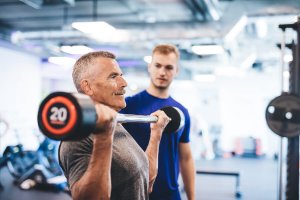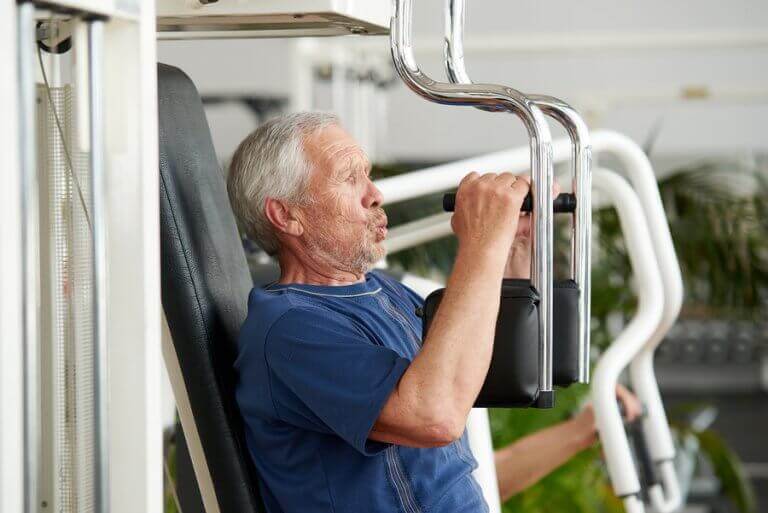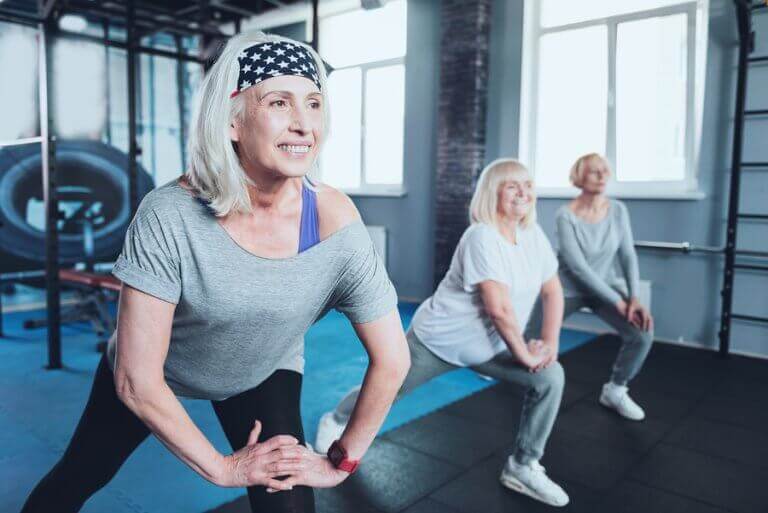Muscle Strength and Longevity: Everything you Need to Know

As we get older, working on our muscle strength acquires a very important role when it comes to dealing with the effects of aging and increasing our longevity. But it’s also very important on a mental level; it helps to improve our self-esteem and allows us to be more functional throughout the day.
At the end of the day, aging can act as a vicious cycle: a person becomes less agile when losing functionality and since they’re doing fewer activities, their self-esteem starts to drop. In today’s article, we’ll tackle the importance of muscle strength training as a tool to cope with the passage of time. We’ll also give you some tips to perform this type of training once you reach a certain age.
Muscle strength in old age
Nowadays, people of old age perform natural movements as a part of their every day life. Activities such as climbing up the stairs, walking to the store instead of driving there or simply performing household chores are the keys to avoid having a sedentary life. Because of this, they promote longevity.
Similarly, strength training has great benefits on more than just a health level. It makes us feel confident and makes our muscles stronger. It also helps to keep the muscle tissue in good condition.
At the same time, it allows the joints to remain stable, helps our body to stay within a healthy weight and it’s great to prevent injuries that can happen in our day-to-day life.
Tips to work on muscle strength in old age
Beyond all of this, once we reach a certain age, it’s important to follow some tips so that strength training has a positive effect. Let’s list them below:
- The importance of technique. As we know, having a good technique is essential when it comes to performing any exercise. For people in this age group, it’s even more important. It’s vital to pay attention to our breathing and posture control. We must also become familiar with our limitations in order to execute the exercises correctly and reduce the risk of injury.

- Look for the perfect practice location. It can be a closed facility or out in the open air. In many cases, the place that you choose is irrelevant. The most important factors are the techniques you use and the intensity you can keep up with.
- Follow an adequate progression. To reduce the risk of possible injuries, it’s essential to start lifting feasible weights that don’t require too much effort. Try to perfect your technique while you’re at it. This way, you can increase the load gradually.
- It’s important to know your own limitations and body. It’s interesting to know a bit about how our anatomy works so that you can perform the exercises in a balanced way.
- Be efficient. It doesn’t matter how long you exercise for, the important thing is the quality of the workout in itself. Experiment and try different routines until you find one that adapts the best to your possibilities. Of course, you should always have the supervision of a professional in the field of sports science.
- What we don’t use, we lose. This is the harsh reality: a muscle that we don’t work will weaken as we get older. It’s important that we make an effort to maintain strong, flexible and agile muscles as much as we can.
Why should you do strength training to increase your longevity?
Several studies have been able to prove that strength training in older people can slow down the loss of muscle strength. These studies claim that muscle training generates significant increments in the levels of strength for both young and older people.
At the same time, other studies claim that the improvement in the levels of strength that happens in older people after a certain workout is due to a greater increase in their motor units. This last aspect favors the increase of muscle size, or muscle hypertrophy, at the same time.
The effects of training on muscle strength
Until now, physical training from the age of 60 was often limited to a few aerobic activities such as walking. However, it’s important to pay attention to how the passage of time can affect the neuromuscular system.
To deal with the damage to this system, strength exercises should be a part of the training program for any elderly person. This will help them to remain as functional as possible.

On the other hand, strength programs for people in this age group will help to correct any problem that may exist in their walking pattern. They will also be able to prevent other risks, such as falls.
Studies have proved that after elderly people adopt a strength program, their quality of life and functional independence usually increase.
Conclusions
As we’ve been able to see, working on muscle strength with a good training program can help to make the passage of time easier for people who practice it quite regularly. Follow the tips we covered in this article and you’ll be able to see how your quality of life increases considerably. It’s a great way to live better!
As we get older, working on our muscle strength acquires a very important role when it comes to dealing with the effects of aging and increasing our longevity. But it’s also very important on a mental level; it helps to improve our self-esteem and allows us to be more functional throughout the day.
At the end of the day, aging can act as a vicious cycle: a person becomes less agile when losing functionality and since they’re doing fewer activities, their self-esteem starts to drop. In today’s article, we’ll tackle the importance of muscle strength training as a tool to cope with the passage of time. We’ll also give you some tips to perform this type of training once you reach a certain age.
Muscle strength in old age
Nowadays, people of old age perform natural movements as a part of their every day life. Activities such as climbing up the stairs, walking to the store instead of driving there or simply performing household chores are the keys to avoid having a sedentary life. Because of this, they promote longevity.
Similarly, strength training has great benefits on more than just a health level. It makes us feel confident and makes our muscles stronger. It also helps to keep the muscle tissue in good condition.
At the same time, it allows the joints to remain stable, helps our body to stay within a healthy weight and it’s great to prevent injuries that can happen in our day-to-day life.
Tips to work on muscle strength in old age
Beyond all of this, once we reach a certain age, it’s important to follow some tips so that strength training has a positive effect. Let’s list them below:
- The importance of technique. As we know, having a good technique is essential when it comes to performing any exercise. For people in this age group, it’s even more important. It’s vital to pay attention to our breathing and posture control. We must also become familiar with our limitations in order to execute the exercises correctly and reduce the risk of injury.

- Look for the perfect practice location. It can be a closed facility or out in the open air. In many cases, the place that you choose is irrelevant. The most important factors are the techniques you use and the intensity you can keep up with.
- Follow an adequate progression. To reduce the risk of possible injuries, it’s essential to start lifting feasible weights that don’t require too much effort. Try to perfect your technique while you’re at it. This way, you can increase the load gradually.
- It’s important to know your own limitations and body. It’s interesting to know a bit about how our anatomy works so that you can perform the exercises in a balanced way.
- Be efficient. It doesn’t matter how long you exercise for, the important thing is the quality of the workout in itself. Experiment and try different routines until you find one that adapts the best to your possibilities. Of course, you should always have the supervision of a professional in the field of sports science.
- What we don’t use, we lose. This is the harsh reality: a muscle that we don’t work will weaken as we get older. It’s important that we make an effort to maintain strong, flexible and agile muscles as much as we can.
Why should you do strength training to increase your longevity?
Several studies have been able to prove that strength training in older people can slow down the loss of muscle strength. These studies claim that muscle training generates significant increments in the levels of strength for both young and older people.
At the same time, other studies claim that the improvement in the levels of strength that happens in older people after a certain workout is due to a greater increase in their motor units. This last aspect favors the increase of muscle size, or muscle hypertrophy, at the same time.
The effects of training on muscle strength
Until now, physical training from the age of 60 was often limited to a few aerobic activities such as walking. However, it’s important to pay attention to how the passage of time can affect the neuromuscular system.
To deal with the damage to this system, strength exercises should be a part of the training program for any elderly person. This will help them to remain as functional as possible.

On the other hand, strength programs for people in this age group will help to correct any problem that may exist in their walking pattern. They will also be able to prevent other risks, such as falls.
Studies have proved that after elderly people adopt a strength program, their quality of life and functional independence usually increase.
Conclusions
As we’ve been able to see, working on muscle strength with a good training program can help to make the passage of time easier for people who practice it quite regularly. Follow the tips we covered in this article and you’ll be able to see how your quality of life increases considerably. It’s a great way to live better!
All cited sources were thoroughly reviewed by our team to ensure their quality, reliability, currency, and validity. The bibliography of this article was considered reliable and of academic or scientific accuracy.
- Hakkinen, K. & Hakkinen, A. (1995): Neuromuscular adaptations during intensive strength training in middle-aged and elderly males and females. Electromyograph. Clin. Neurophysiol. 35: 137-147.
- Izquierdo, M; y Aguado, X. (1999): Adaptaciones neuromusculares durante el entrenamiento de fuerza en hombres de diferentes edades. Apunts: Educación Física y Deportes. 55: 20-26.
- Moritani, T. & Devries, H. A. (1980): Potential for gross muscle hypertrophy in older men.J. Gerontology. 35: 672-682.
This text is provided for informational purposes only and does not replace consultation with a professional. If in doubt, consult your specialist.








